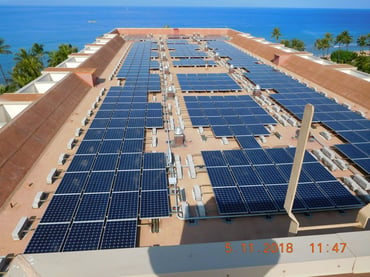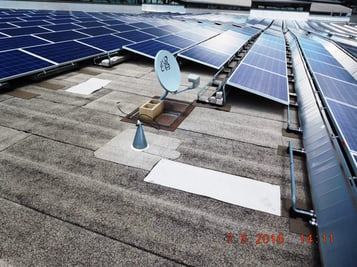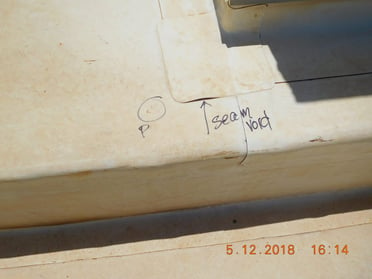By Jeff Evans, RRC
It has been our experience that most building owners follow the “run-to-failure” method of roof management. They invest in a new roof, ignore it, and hope they can get 20 years of serviceable life. This is a passive approach to roof management, and requires little in the way of decision-making. Patch it when it leaks; then eventually admit defeat and replace the roof.
As low-sloped rooftops have become prime real estate for photovoltaic (PV) solar installations, building owners need to be more deliberate, thoughtful and proactive when making roofing decisions. The decision to add rooftop PV is typically financially driven – and the added cost of roof improvements is important to consider when judging feasibility and financial return.
In a perfect world, a new solar array would be installed over a new roof with an expected design life matching the solar panel warranty (often 25 years). It would also be best if the new roof was truly “solar ready”; a roof system design geared toward durability and requiring little maintenance for long-term performance. Unfortunately, what we see in the marketplace is solar decisions being made without regard to the age, condition, and type of roof system in place. Roof management, leak response, and eventual roof replacement all become much more problematic and expensive. When a solar project is contemplated on an existing building, the first question asked should be: “Is the existing roof sufficiently robust in design to accept the solar overburden?” We have seen building owners accept placement of solar installations on roofs that aren’t suitable or “solar ready.”
We have observed solar arrays installed on roofs that are too old, where the roofs will need to be replaced during the service life of the solar array. When a roof covered by a solar array requires replacement, building owners are burdened with decommissioning and recommissioning the system; including costs and lost revenue associated with removal, reinstallation, and downtime.
So, what strategies can be employed on roofs with solar arrays already in place, or when considering addition of PV over an existing rooftop? Here are several case studies and Benchmark’s recommended roof management approach for each scenario.
Case Study #1: Resort Hotel
A rooftop PV installation was proposed at a large resort hotel, which is serviced by eight-year-old modified bitumen roof systems. The roofs were performing well, but had developed light surface cracking as a result of high ultraviolet (UV) loading and tropical heat. The underlying “bones” of the roofs were sound, but our assessment determined that the roof membranes would not be capable of performing for 25 additional years to match the PV system lifespan. Less than ten additional years of service was anticipated, especially without addressing the surface deterioration.
We felt the three basic roof management choices included “run-to-failure,” roof replacement, or coating the membrane to correct/abate the surface deterioration. Running-to-failure would require removal and re-installation of the solar array, we estimated, less than ten years from the date of the PV system’s installation. Conversely, reroofing was definitely premature and unnecessary.

Solar panel installation can limit accessibility for repairs.
Our recommendation was to resurface the roof with a Poly(methyl methacrylate) (PMMA) coating prior to installing the solar array. The coating was intended to provide protection against further UV deterioration, and extend the roofs’ life expectancy beyond the “run-to-failure” approach. Performance of the coated roofs was not expected to equal the 25-year solar panel lifespan, but we felt this approach would defer the roof replacements long enough to justify the cost of coating.
Case Study #2: Shopping Center
Prior to our involvement, this 400,000 square foot shopping center had 35 percent of its roofs covered with solar panels. The existing roof systems consisted of 15-year-old, granule-surfaced, two-ply modified bitumen membranes over rigid insulation. Benchmark was retained to conduct a roof evaluation, which noted loss of surfacing granules, membrane surface cracking, and system-wide blistering of the top membrane ply. Our infrared scan also showed numerous random areas of wet insulation throughout the roofs.
We concluded that reroofing was not immediately required, but should be anticipated within 5 to 7 years with continuation of the typical “run-to-failure” roof management approach.

Imposing a solar array on an older roof is inadvisable, due to eventual reroofing need.
Many of the roof sections on the shopping center are landlocked, with poor access for future construction. The building’s geometry, with multiple roof levels, tall area dividers, and poor construction access would collectively drive-up the eventual reroofing costs. Reroofing would also disrupt the solar energy production, a cost that would need to be absorbed by the building owner. And, removal and reinstallation of the solar array would be complicated and costly, due to the same logistical factors affecting the roofing work.
We again recommended a fairly proactive roof “restoration” approach. The recommended process included widespread membrane blister repairs, spot removal, replacement of wet insulation areas, and installation of an elastomeric coating system. Similar to Case Study #1, the coating was intended to address the surface deterioration, and improve the future UV and heat resistance of the exposed roof areas.
While the preference would have been to coat the entire roof surface, we felt the cost of coating under the difficult-to-access solar arrays was neither necessary or cost effective. In this case, the coating was recommended at the exposed membrane areas between solar panels, and extending under the edges. The shaded areas under the array would not be as susceptible to future UV deterioration as the exposed square footage, and could therefore be omitted. This restoration project was far less expansive and disruptive than reroofing, and did not require interruption of the existing PV system.
Case Study #3: Resort Hotel
This resort was completely redeveloped and renovated in 2012. As part of the improvements, a new adhered thermoplastic polyolefin (TPO) roof system was installed, with a 20-year manufacturer’s warranty provided. The client was considering a solar installation proposal and contacted Benchmark to conduct a roof evaluation prior to judging the overall cost impact and deciding how to proceed.
Benchmark found the TPO roof system to be performing well, with no visible effects of weathering. However, the roof had a fair amount of “dings and dents,” scratches in the membrane, and a number of membrane punctures. We also identified the roofing manufacturer and the warranty information, which the resort’s management was not aware.

Preparing a roof to accept a new solar array includes repairing any roof membrane defects
Benchmark recommended that all current membrane punctures and scratches be repaired to an “as new” condition prior to installing the new solar array. This would also allow the facility to “turn over” their roof to the PV contracting team in an “as new” condition. Any subsequent damage would then be the responsibility of the solar installer to correct.
We also recommended that the facility require the contracting team use a manufacturer-approved roofing subcontractor to install the new TPO membrane flashings required to detail the many new PV system penetrations. The solar installer would also be required to arrange and pay for a follow-up inspection by the roofing manufacturer’s technical representative. Further, the installer would be required to provide any corrective work identified by the manufacturer, in order to ensure that the TPO roof warranty coverage would not be jeopardized.
Case Study #4: Warehouse Facility
This facility had a ballasted PV array installed when the existing 48-mil mechanically fastened PVC roof system was approximately 15 years old. That was 9 years ago, and the roof is now 24 years old. As the roof membrane has aged, deficiencies and associated leaks have developed. Repairs have generally been effective where the roof was accessible; however, finding and correcting deficiencies have proven very difficult where the roof was inaccessible under the arrays.
This roofing dilemma could have been anticipated. The roof was nearing the end of its service life, but the solar array was in the middle of its service life. Leaks are a certain business disruption, but next to impossible to correct. Reroofing was clearly justified, but the associated cost was very high due to the solar-related challenges.
The client asked for our opinion of the potential success and usefulness of coating the areas under the PV arrays, an attempt to plug leaks and forestall reroofing. While we have coated PVC membrane roofs in the past to provide short term correction of hail damage, we felt the physical challenges of working under an operating PV array would be problematic. Coating a PVC roof (and most other roof types) requires the roof surface to be clean – to allow for proper bonding of the coating. Perhaps an inventive contractor could devise a method to clean and coat, but we felt it was likely to be an unworkable solution.
Miscellaneous Factors
As we see more and more rooftop solar arrays being considered and implemented, we have observed some unexpected outcomes: We have found that low slung, ballasted rack systems tend to be collection devices for debris and vegetation. Over time, this collection of debris could be detrimental to roof and drainage performance. In at least one seaside location, we have witnessed seagulls roosting on the panels, which results in soiling of the panels with bird scat. We learned that one such roof had not previously been of interest to seagulls until the panels were added. Periodic cleaning of the panels is required, which then results in soiling of the roof. Time will tell if there are any long-term effects on the roof from the birds or associated cleaning. The structure’s ability to accept the additional roof load, and the solar array’s wind uplift resistance are critical elements to assure proper performance. Solar arrays, particularly ballasted assemblies, can vibrate and move over time due to wind. This can cause roof membrane wear and tear. Adding a solar array to an existing roof-top requires an understanding of the existing roof system, its suitability and its durability. Failure to gain that understanding, risks future roof performance deficits, as well as financial and operational risks.
